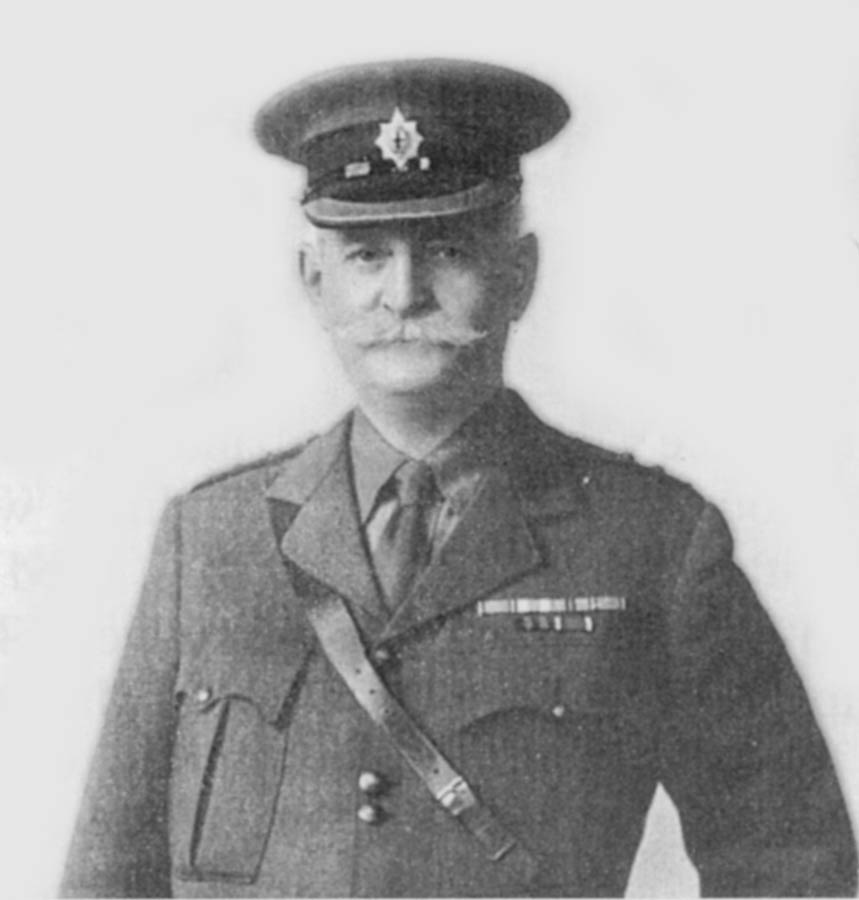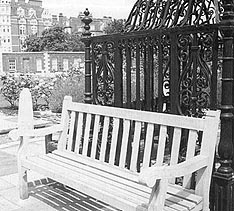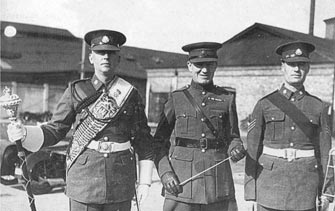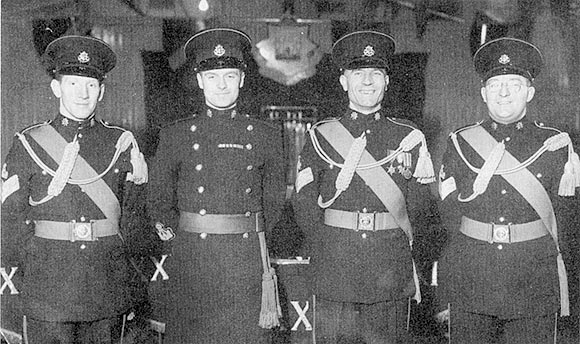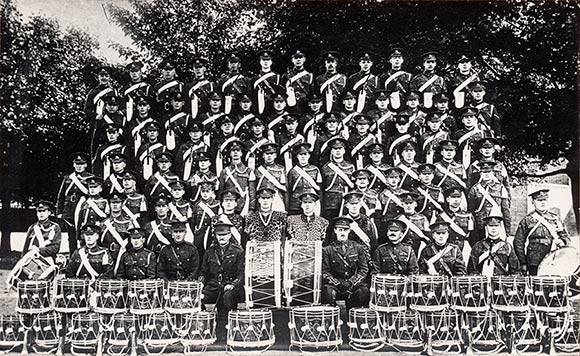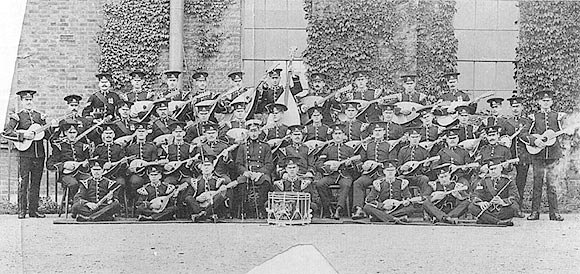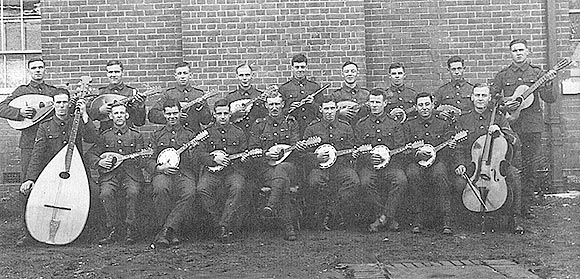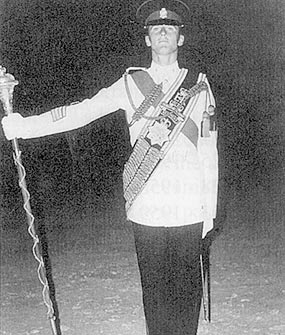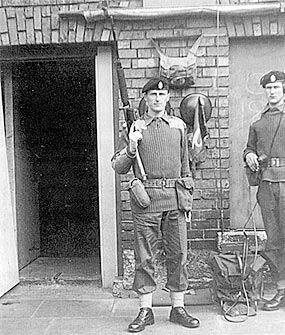Band and Drums Music
Some Band & Drum Personalities
All Regiments in their time produce certain outstanding officers and men, 'characters', is the word commonly applied, and both The Queen's and The Surreys have certainly not been lacking in that respect. So it might be as well to look at some of them, particularly in our Bands and Drums. First to come under our consideration are Regimental Bandmasters many of whom, like Field Marshals, were distinguished holders of the baton. So it will be appropriate to start with one of the greatest, if not the greatest, of them all.
Lieutenant Colonel John Mackenzie Rogan CVO. (Queen's)
He joined the Army on February 4th 1867 as No. 1832 Boy John M Rogan, aged 15 years, 2nd Battalion (North Devon) Regiment of Foot. He was destined to become a legend in the sphere of military music.
Lieutenant Colonel
John Mackenzie Rogan, CVO
(Enlarge image)
After serving with the 11th Foot at home, in South Africa and India, Rogan, then a Drum-Major, was sent to Kneller Hall in January 1880 to qualify as a Bandmaster. Obviously making his mark, he was appointed Acting Sergeant Major of the Establishment.
In May 1882 he was appointed Bandmaster of the 2nd Queen's then serving at Peshawar. Finding the Band under strength, mainly due to discharges, he enlisted men from the ranks and boys from home and the Sanawar School and trained them all to a high standard of perfection. His skills were not confined to music. At cricket he played in the Regimental eleven and he was also an above average shot. He was selected and transferred in 1895 to the Coldstream Guards with whom he reached the zenith of his career, twice taking the band to Canada. During the First World War he made three tours of battle areas and later took the Guards Massed Bands through Italy.
Mr Rogan was the first bandmaster in the Brigade of Guards to be granted a Substantive commission, being promoted to the rank of 2nd Lieutenant in 1904; after passing through all the various ranks he retired as a Lieutenant-Colonel. Never before had a serving bandmaster or director of music attained this rank.
For 20 years Lt-Col Rogan was the senior director of music of the Brigade of Guards, and he was responsible for the massed bands of the Brigade at the funeral of Queen Victoria, the coronation of King George V. Amongst the many decorations and awards that he received were the Commander of the Royal Victorian Order, Officer (Knight) of the Order of the Crown of Belgium, Cavaliere of the Order of the Crown of Italy and Officer of the Black Star of Benin (France). His service medals consisted of the Silver Medal Queen Victoria's Jubilee, Silver Medal Royal Victorian Order, Long Service Medal, Burmah Medal and two clasps (1885-87 and 1887-1889), Victory Medal, General Services Medal and Coronation Medal (1911). In October 1904 he was elected Honorary Member of the Royal Academy of Music, and in 1907 the Senate of the University of Toronto conferred an honorary Director of Music degree on him. He retired in 1950.
After leaving the Army in 1920 he continued his musical interests particularly with the British Legion of whom he became Honorary Director of Music. He took considerable part in the arrangements for the Armistice Night music festival at the Albert Hall. On his death there was a telegram of sympathy from HM King George V and a letter from HRH The Prince of Wales together with magnificent floral tributes from military and civilian friends and associates. Whilst it is accepted that Lt Col Rogan was an outstanding Bandmaster and Director of Music he also wrote his autobiography 'Fifty years of Army Music '. Extracts from this, tell not only the story of music in the Army, The Queen's and The Coldstream Guards but of soldiering in India, Burma and other stations in the world during the last years of the nineteenth century.
Bandmaster Roger Barsotti (Queen's)
Of later vintage, but certainly of no less distinction, was Bandmaster Roger Barsotti MBE. A distinguished military musician of his time he was Bandmaster of 2nd Bn The Queen's Royal Regiment.
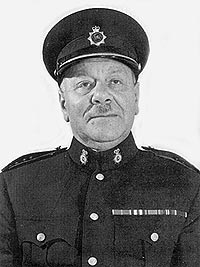 |
| Roger Barsotti in the uniform of Director of Music, Metropolitan Police Band (Enlarge image) |
Born in London in 1901, he was taught by his father, Luigi Barsotti, a professional musician and one-time professor of the Milan Conservatoire. Roger made his debut at the age of fourteen as a deputy flautist with the Hastings Municipal Orchestra. Joining the Buffs as a bandboy in 1916, he was promoted to Band Sergeant at the age of twenty-two. On passing out of the Royal School of Music, Kneller Hall in 1930 he was appointed Bandmaster of 2nd Bn The Queen's Royal Regiment, a position he held for fifteen years. A photograph taken in 1937 shows the band to have been 52 strong, though by that time war clouds were gathering and the bandsmen were preparing to take up their secondary role.
Mr Barsotti's industry and leadership were such that, within a few months of the outbreak of war, he had built a new band at the Regimental Depot capable of playing for all occasions.
On retirement from the Army, after nearly thirty years service, he was appointed Director of Music to the Metropolitan Police Band in 1946. In 1958 and 1960 he had the honour of being asked to adjudicate at the National Brass Band Championships held at the Albert Hall. He was awarded the MBE in the Birthday Honours in 1961. Retiring from the Metropolitan Police Band in October 1968, he became Director of Music for the Royal Parks for some time. He died in 1986 after a prolonged illness.
Bandmasters Barthmann, Gready and Gidney (Queen's)
Three former 'characters" of vastly different calibre were 19th century Bandmasters Barthmann, Gready and Gidney, all of The Queen's. The first was of undoubted musical ability but his conduct was classed as 'irregular' in 1865 and 'intemperate discharged' in 1868. The second in 1879 was reported as 'conduct good, musical ability very good, general usefulness useless - Remarks - discharged'.
His successor Bandmaster William Gidney, was not much better as after fifteen months he was returned to Kneller Hall as 'unsatisfactory'.
Bandmaster Mynbeer Dittrich (70th)
The East Surrey Regiment and its predecessors were not lacking in musical talent. The earliest known Bandmaster of the 70th Foot was Mynbeer Dittrich, believed to a German who was appointed in the late 1880's. He accompanied the Regiment to New Zealand in 1861 and although he appears to have stayed for only a few months he was reputedly popular with both the troops and the local population. He formed a successful choral class at the Otahuhu Institute.
Bandmaster W Vines (31st) and Bandmaster Charles Joiner
In 1869 Bandmaster W Vines was appointed to the 31st by Kneller Hall with Bandmaster Charles Joiner coming to the 70th in 1878. He died in service in 1883.
The two Regiments of Foot the 31st and 70th were amalgamated under the Army Reforms of 1881 to form The East Surrey Regiment. It is known that Bands accompanied Battalions on overseas service but information regarding individual Bandmasters is limited. A Corporal Wernham, presumably as a voluntary effort, formed an orchestra while stationed at Rawalpindi between the wars. But the Bands must have been well led as on one occasion Lieutenant Colonel (Ret'd) Mackenzie Rogan, seated in the audience in Gibraltar, praised the performance of the 2nd Battalion musicians.
Bandmaster Cyril Harriott (East Surrey)
On commencement of the Second World War the 1st Battalion, on Home Service, received into their ranks, Bandmaster Cyril Harriott who moved to the Regimental Depot to form a new band.
Memorial seat at Royal Hospital, Chelsea, to the memory of Bandmaster Ernest Manley |
Drum Major E Croot, Bandmaster E Manley and Sergeant Lazard of the 2nd Bn The East Surrey Regiment. |
Less fortunate by far were the 2nd Battalion who, fighting in Singapore with members of The Leicestershire Regiment in the combined British Battalion, were finally over run by the Japanese. Bandsmen were among those taken prisoner, including Bandmaster Ernest Manley who died on 15th January 1945 in Amagaski Camp, Japan. He had enlisted in The Queen's in 1914 and transferred to The East Surreys in 1933.
At home the band made good progress and was kept in being. The two Battalions of the Regiment were amalgamated in 1948 and Bandmaster Harriott took command of the resulting band. Sadly, while on an overseas posting to Tripoli, he was suddenly taken ill and died at the Tel-EI-Kebir Military Hospital on 16th August 1953 and was buried the following day. He had completed twelve years service, having enlisted in The Border Regiment in 1926 and transferred to The East Surreys in 1938.
Bandmaster William Snowden (Queen's Surreys)
It fell to his replacement, Bandmaster William Snowden, originally a Coldstream Guardsman who had transferred to the East Surreys in 1953, to take the Band into its amalgamation with The Queen's Royal Regiment in 1959.
Bandmaster Bill Snowden with three NCO's from his band.
Sgt 'Ginger' Hunter, 'Toms' Thompson and 'Perky' Herne (or Horne).
Bandmasters Fred Short & Tom Crichton (Queen's)
The newly formed Queen's Royal Surrey Regiment, by process of further amalgamation, became part of The Queen's Regiment in December 1966 with Bandmaster Fred Short in post. He retired on compassionate grounds in 1968 and was succeeded by Bandmaster Tom Crichton. He joined the 1st Bn. The Argyll and Sutherland Highlanders at Stirling Castle in 1947 at the age of 16 as a junior Bandsman. As a brass and percussion player he blew and tapped his way through Palestine 1947-48, Hong Kong, Japan and Macao 1949-52 before a motor-cycle accident and an injury to his mouth put paid to his brass playing. He was to remain with 'The Argylls' for eleven more years, during which he served in British Guiana, Berlin, Finland, Cyprus, Turkey, West Germany, Sweden, Russia, America, Canada and, whilst in Scotland, he found time to marry Martha in 1956. After four years at Kneller Hall he was promoted School Sergeant Major in 1966 and in January 1968 joined the 1st Bn as Bandmaster.
Tom is also unconventional in that he must be one of very few Bandmasters who have represented the army at athletics. In his day he was not only a fine 100 metre and 200 metre sprinter but also a good all round games player, representing his Battalion at hockey, basketball and rugby and even gaining a 'colonial cup' as a wing forward in British Guiana.
Tom Crichton was Bandmaster of 1 Queen's for five years and did much to improve and maintain the highest musical standards within the Band. The Band completed a very successful 13 weeks tour of England and Scotland in 1970. The Band moved to Berlin with the Battalion in 1970 for a two year tour and with the Drums had an outstanding record of engagements from Beating Retreat to concerts in the city.
On retirement he went as Director of Music at Gordon Boys School, Woking for a short period before his appointment as Director of Music of The Royal Oman Band in 1977. He retired (finally) in 1991 to his beloved home town of Callender in Scotland after a long and distinguished musical career from Bandboy to Colonel.
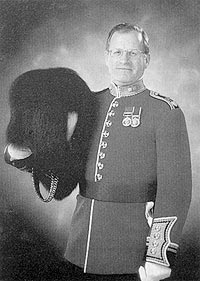 |
| Bandmaster Phillip Hills |
Bandmaster Phillip Hills (Queen's)
The Queen's Regiment reduced to two Bands in 1984, they were named The Albuhera and Quebec Bands. The first Bandmaster of the Albuhera Band was Bandmaster Phillip Hills who had been the bandmaster of 1 Queen's Band. He joined the Army in June 1963 as a Junior Musician in the Royal Artillery. After a pupils course at Kneller Hall he joined the Royal Artillery Mounted Band, serving with them in Aldershot and Dortmund. He transferred to the Band of the Welsh Guards in 1972. After successfully completing his Bandmasters Course he was appointed Bandmaster of the 1st Ban The Queen's Regiment. He served with them in Werl, (then W Germany) the UK and tours of Northern Ireland.
In 1985 he returned to Kneller Hall to become the School Bandmaster, and was Commissioned in 1987 into The Black Watch (The Royal Highland Regiment) he was Director of Music Infantry (North) who had responsibility for the Bands of Scottish and Kings Divisions. 1988 saw him appointed Senior Director of Music HQ BAOR, being responsible for all Army Bands in West Germany.
He was appointed Director of Music of the Royal Artillery Alanbrooke Band in 1989 thus returning to the Regiment in which he had started his career.
In August 1992 he was appointed Director of Music, Grenadier Guards. He toured with the Band in mainland Europe, North America and Australia. He was promoted Lieutenant Colonel in 1999 and appointed Senior Director of Music Guards Division.
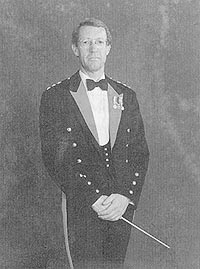 |
| Bandmaster T S Davis |
Bandmaster T S Davis (Queen's)
Bandmaster T S Davis succeeded Mr Hills as Bandmaster of the Albuhera Band, he had previously been Bandmaster of the 3rd Battalion Band The Queen's Regiment and Bandmaster of The Queen's Division at Bassingbourne.
He was commissioned into The Queen's Regiment in 1987 and appointed Deputy Chief Instructor of The Royal Military School of Music, Kneller Hall. In 1990 he was appointed Director of Music Royal Army Ordnance Corps, two years later he moved to the Royal Artillery Woolwich Band. In 1997 he was appointed Director of Music The Welsh Guards Band. Tragically his untimely death in May 1998 cut short a brilliant musical and military career.
Mr I R People (PWRR)
The last Bandmaster of the Albuhera Band was Mr I R People, he was later commissioned and became Director of Music Corps of the Royal Electrical and Mechanical Engineers Band.
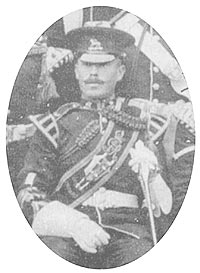 |
| Drum Major Joseph Winter |
Drum Major Joseph Winter (Queen's Royal)
Having joined in 1899, Joseph Winter ended his Army service in April 1920 as a Drum Major of the Queen's Royal Regiment, (West Surrey) and went to work as the corps of drums representative for Henry Potter and Co (Drums) Ltd, who existed from 1900-1971 at 36-38 West St London, just off the Charing Cross Road. By all accounts, he declined offers of promotion in order to remain as Drum Major. He had been a most famous WWl Drum Major, about whom though, there is probably more legend than fact. In 1912 in Warley, he formed an excellent mandolin band, (which was later to be amongst the BBC's earliest performers). The mandolin band was reformed after the First World War.
During the Great War, the 1st and 2nd Battalions of the Queen's Royal Regiment (West Surreys), were obliterated. Thus it was that in 1916, Winter found himself reforming both their corps of drums in the trenches. The 1917 reforms that acknowledged the relevance of 'Drums to morale, were clearly alive even then. He saw them broken up yet again, and had to form two new corps after the war. He took part in the 1919 victory parade in Paris (along with another former West Surrey, Lt Col MacKenzie-Regan - a former Bandmaster of the regiment who was an admirer of Winter's ability). Winter was awarded the Meritorious Service Medal in 1917.
Winter is understood to have been something of a martinet during his Army service, then one of nature's gentlemen once retired, yet his 'Drums was perhaps "the happiest family in the regiment". This former should not be dismissed too lightly, as men of the period was expected to be fierce within the Army, indeed, it was the way in which great things were achieved and he certainly had that especial kind of trust that had the officers leave him to get on with things on his own. Without people of this calibre and style surviving, affairs in 1915 must just have been less fortunate for the nation. He did not marry until after leaving the service.
Drums Of The 1st And 2nd Bns The Queen's Royal Regiment
Aldershot, August 1919
In 1919 both regular battalions of the Queen's, reduced to cadre, returned from France. Throughout the summer the 1st Battalion was involved in internal security duties in the Midlands, while the 2nd Battalion was at Aldershot for a few months before being posted to India.
Advantage was taken of the experience of Drum Major Winter of the 2nd Queen's to. form two Corps of Drums, one for each battalion. This unique photograph shows the Drums of both battalions shortly before the 2nd Battalion embarked for India.
The Commanding Officer, Lt Col L M Crofts DSO is to the left of the bass drums, and his Adjutant, Capt R K Ross DSO MC to the right. Drum Major Winter is next to Captain Ross.
The Mandolin Band formed by D/M Winter, Warley 1912
His travelling representation of Henry Potter continued until the Second World War when he became semi-retired and worked in the shop on flute and bugle march stockage (his system for which allowed for a stock of bass drum parts to have survived to this date!). It is believed that much of his composition occurred in the period 1919-23. For all that, not much is known of his work other than specific marches. He did compile "Henry Potter's Side Drum Tutor" (date not known- but with the London address) but whether any of the flute and bugle works owe anything to him is not known. He finally finished working for the London Potter's about 1961 and went to live with his daughter in Greenford, where he is believed to have died in 1963.
The reformed Mandolin Band, Aldershot 1923.
In 1912 D/M Winter formed a mandolin band.
Many of the original drummers were killed or discharged after the First World War.
The mandolin band was reformed after the war and was very successful. It was included in several BBC radio programmes.
Winter's compositions, several of which are still played today include, Gommecourt, Le Cateau, Gheluvelt, Remember Louvain, St Jean, Bapaume, The Promenade, Des Pierettes, Silver Lane, Charing Cross, Mandora, Tourney, Badajos, Gloria de Mia (waltz), a setting of The Ash Grove, Druid's Prayer (waltz).
Drum Major M D (Max) Maloney (Queen's)
'Max' Maloney' was born within the sound of Bow Bells on the 15th August 1942. He enlisted as a Junior Drummer in November 1958 and did his initial training at Canterbury.
| Drum Major M D (Max) Maloney | Drum Major Max Maloney 1 Queen's in his other role! |
In 1960, he was posted to 1st Bn The Queen's Royal Surrey Regiment then stationed at Colchester. He moved with the battalion to Aden and then Hong Kong. By 1962 he had been promoted Corporal. In Munster he was promoted Drum Sergeant and then spent an eighteen month tour as a Regiment Recruiter. He joined the 1st Battalion in Bahrain and was appointed Drum Major on The Glorious First of June 1968. On return from Bahrain the battalion undertook its first of many tours in Ulster, in Londonderry.
During Public Duties in 1970 Max created quite a stir when marching to and from Buckingham Palace and St James Palace by repeatedly throwing the staff into the air. The crowds loved it, the Commanding Officer loved it but certain other London dignatories were not amused!
On return to Bulford, and after several tours in N Ireland Max left the Drums and went to duty as a Company Sergeant Major. He had served fourteen years with the Corps of Drums, five of them as Drum Major.
He was awarded the British Empire Medal for gallantry in 1973 when in Belfast. He was promoted Regimental Sergeant Major of the 617th Bn The Queen's Regiment in 1976. He was commissioned in January 1979 and served initially with the 3rd Battalion. He left the Army in April 1987 in the rank of Major after completing 28 years Boy and Man service. On 17th July 1988, Garter King of Arms, Colonel Sir A Colin Cole KCVO, FSA, TD, handed Major Max Maloney BEM a scroll making him a Freeman of the City of London.
Related
